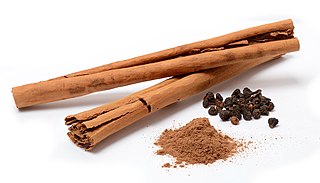
Cinnamon is a spice obtained from the inner bark of several tree species from the genus Cinnamomum. Cinnamon is used mainly as an aromatic condiment and flavouring additive in a wide variety of cuisines, sweet and savoury dishes, breakfast cereals, snackfoods, tea and traditional foods. The aroma and flavour of cinnamon derive from its essential oil and principal component, cinnamaldehyde, as well as numerous other constituents including eugenol.

The flowering plant family Lauraceae, the laurels, includes the true laurel and its closest relatives. This family comprises about 2850 known species in about 45 genera worldwide. They are dicotyledons, and occur mainly in warm temperate and tropical regions, especially Southeast Asia and South America. Many are aromatic evergreen trees or shrubs, but some, such as Sassafras, are deciduous, or include both deciduous and evergreen trees and shrubs, especially in tropical and temperate climates. The genus Cassytha is unique in the Lauraceae in that its members are parasitic vines.

Cassia is a genus of flowering plants in the legume family, Fabaceae, and the subfamily Caesalpinioideae. Species are known commonly as cassias. Cassia is also the English common name of some species in the genus Cinnamomum of the family Lauraceae. Species of the genera Senna and Chamaecrista were previously included in Cassia. Cassia now generally includes the largest species of the legume subtribe Cassiinae, usually mid-sized trees.

The brown four-eyed opossum is a pouchless marsupial of the family Didelphidae. It is found in different forested habitats of Central and South America, from Nicaragua to Brazil and northern Argentina, including southeastern Colombia, Paraguay and eastern Peru and Bolivia, at elevations from sea level to 1500 m. It is the only recognized species in the genus Metachirus, but molecular phylogenetics studies suggest that it should probably be split into several species. Population densities are usually low, and it is uncommon in parts of Central America. A density of 25.6/km2 was reported near Manaus, Brazil. Its karyotype has 2n = 14 and FN = 24.
Western pebble-mound mouse or Ngadji, species Pseudomys chapmani, is a burrowing and mound building rodent in the family Muridae. They are occur in the Pilbara, a remote region in the northwest of Australia.
Cassia aldabrensis is a species of plant in the family Fabaceae endemic to Assumption and Aldabra near the Seychelles. It is threatened by habitat destruction.
Cassia aubrevillei is a plant species in the family Fabaceae. A forest tree of tropical West Africa, it is threatened by deforestation and unsustainable logging for timber. The bark of the tree has been investigated for antifilarial properties.
Cassia fikifiki is an uncommon small rainforest species of tree in the family Fabaceae. It is found in Côte d'Ivoire and Liberia. It is a deciduous tree with a showy pendulous inflorescences of bright yellow flowers, and is easily confused in foliage with the common savanna tree Cassia sieberiana.
Ostodes is a genus of tropical land snails with gills and an operculum, terrestrial gastropod mollusks in the family Neocyclotidae.
Beauprea congesta is a species of plant in the family Proteaceae. It is endemic to New Caledonia.

Helicia is a genus of 110 species of trees and shrubs, constituting part of the plant family Proteaceae. They grow naturally in rainforests throughout tropical South and Southeast Asia, including India, Sri Lanka, Indochina, Peninsular Malaysia to New Guinea and as far south as New South Wales.
Helicia albiflora is a species of plant in the family Proteaceae. It is endemic to Papua New Guinea. It is threatened by habitat loss.
Helicia peltata is a species of plant in the family Proteaceae. It is endemic to Papua New Guinea. It is threatened by habitat loss.
Helicia retusa is a species of plant in the family Proteaceae. It is endemic to Papua New Guinea.
Roupala sphenophyllum is a species of plant in the family Proteaceae. It is endemic to Peru.
Stenocarpus dumbeensis was a species of plant in the family Proteaceae. It was endemic to New Caledonia.

Cinnamomum osmophloeum, commonly known as pseudocinnamomum or indigenous cinnamon, is a medium-sized evergreen tree in the genus Cinnamomum. It is native to broad-leaved forests of central and northern Taiwan.
Cinnamomum citriodorum is a species of flowering plant in the family Lauraceae. It is endemic to Western Ghats and Sri Lanka. It is commonly known as Malabar Cinnamon. It has a characteristic smell of lemon grass. C. citriodorum has 45% Cinnamaldehyde compared to 80% for C. cassia.

The Cassia crossbill is a passerine bird in the family Fringillidae. It is endemic to the South Hills and Albion Mountains in southern Idaho. Cassia crossbill rarely interbreeds with other call types that move into the South Hills of Idaho yearly, and can be considered to represent a distinct species via ecological speciation. The Cassia crossbill have specialized beaks to access the seeds of the lodgepole pine cones in this region, but are poorly adapted to other pine cones in surrounding regions.
Acalolepta artensis is a species of beetle in the family Cerambycidae. It was described by Xavier Montrouzier in 1861, originally under the genus Monochamus. It is known from New Caledonia.







